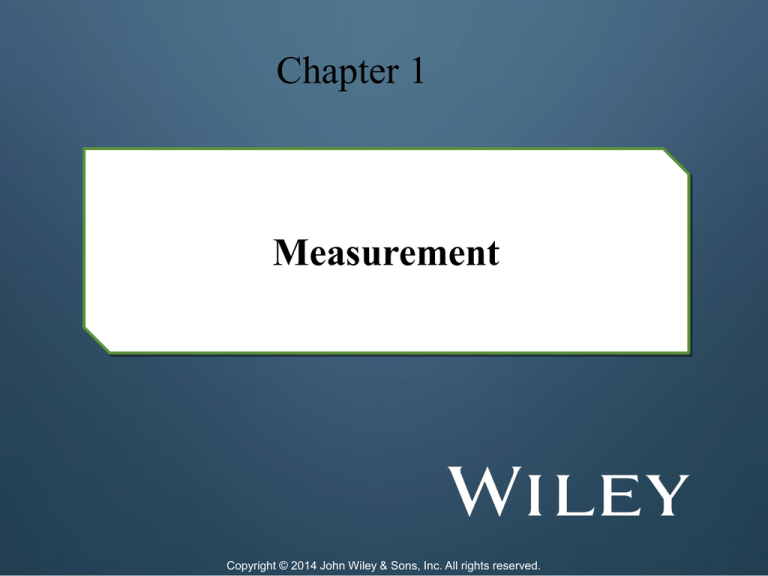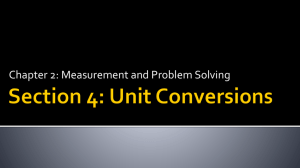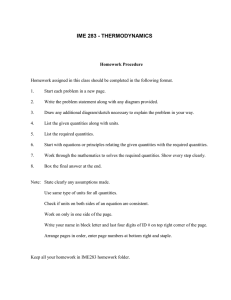
Chapter 1
Measurement
Copyright © 2014 John Wiley & Sons, Inc. All rights reserved.
Quantities Physics
There are two Types of Quantities Physics :
1- Base quantities : (Fundamental Quantities)
2- Derived quantities :
© 2014 John Wiley & Sons, Inc. All rights reserved.
Quantities Physics
Table System International (SI) base quantities
SI base quantity
Base quantity
length
mass
time
electric current
thermodynamic temperature
amount of substance
luminous intensity or (Unit of intensity of light)
© 2014 John Wiley & Sons, Inc. All rights reserved.
Unit
Symbol
meter
m
kilogram
kg
second
s
ampere
A
kelvin
K
mole
mol
candela
cd
Quantities Physics
The three fundamental physical quantities (base
quantities) of mechanics are length, mass and
time, which in the SI system have the units meter
(m) , kilogram (kg) , and second (s) , respectively.
These fundamental quantities cannot be defined in
terms of more base quantities .
© 2014 John Wiley & Sons, Inc. All rights reserved.
Quantities Physics
Exercise : (Homework) (SI)
The Unit of Length is ………..
The Unit of Time is ………..
The Unit of Electric Current is ………..
The Unit of Temperature is ………..
The Unit of a mount of Substance is ………..
The Unit of Mass is ………..
of more basic quantities .
© 2014 John Wiley & Sons, Inc. All rights reserved.
Quantities Physics
Derived Quantities:
All physical quantities measured by physicists can be
expressed in terms of the three basic unit of length,
mass, and time. For example, speed is simply length
divided by time, and the force is actually mass
multiplied by length divided by time squared.
Derived quantities: area, speed, volume, density .
© 2014 John Wiley & Sons, Inc. All rights reserved.
Quantities Physics
𝐴𝑟𝑒𝑎 = 𝐿𝑒𝑛𝑔𝑡ℎ × 𝐿𝑒𝑛𝑔𝑡ℎ 𝑢𝑛𝑖𝑡 𝑓𝑜𝑟 𝑎𝑟𝑒𝑎 = 𝑚2
𝑽𝒐𝒍𝒖𝒎𝒆 = 𝑳𝒆𝒏𝒈𝒕𝒉 × 𝑳𝒆𝒏𝒈𝒕𝒉 × 𝑳𝒆𝒏𝒈𝒕𝒉 𝒖𝒏𝒊𝒕 𝒇𝒐𝒓 𝒗𝒐𝒍𝒖𝒎𝒆
= 𝒎𝟑
𝐿𝑒𝑛𝑔𝑡ℎ
𝑚
𝑆𝑝𝑒𝑒𝑑 =
𝑢𝑛𝑖𝑡 𝑓𝑜𝑟 𝑠𝑝𝑒𝑒𝑑 =
𝑡𝑖𝑚𝑒
𝑠
𝑀𝑎𝑠𝑠
𝐷𝑒𝑛𝑠𝑖𝑡𝑦 =
𝑉𝑜𝑙𝑢𝑚𝑒
𝑘𝑔
𝑢𝑛𝑖𝑡 𝑓𝑜𝑟 𝑑𝑒𝑛𝑠𝑖𝑡𝑦 = 3
𝑚
© 2014 John Wiley & Sons, Inc. All rights reserved.
Quantities Physics
Systems of Units :
SI units (used mostly in physics):
length: meter (m)
mass: kilogram (kg)
time: second (s)
This system is also referred to as the MKS system for meter-kilogramsecond.
© 2014 John Wiley & Sons, Inc. All rights reserved.
Quantities Physics
Gaussian units (used mostly in chemistry):
length: centimeter (cm) cm = 0.01 m
mass: gram (g)
g= 0.001 kg
time: second (s)
This system is also referred to as the CGS system
for centimeter-gram-second.
© 2014 John Wiley & Sons, Inc. All rights reserved.
Quantities Physics
British engineering system (FPS) :
length: foot (ft)
ft = 0.30 m
mass: bound
bt= 0.45 kg
time: second (s)
© 2014 John Wiley & Sons, Inc. All rights reserved.
Conversion Unit
1 km = 1000 m (meters)
𝟏 𝒎𝒊𝒍𝒆(𝒎𝒊) = 𝟏𝟔𝟎𝟗 𝒎
1 Km is equivalent to 0.6214 miles .
To convert From mile to k𝐦 ×
mi = km × 0.62137
To convert From km to m𝐢𝐥𝐞 ÷
𝒎𝒊𝒍𝒆
km =
𝟎.𝟔𝟐𝟏𝟑𝟕
© 2014 John Wiley & Sons, Inc. All rights reserved.
?
Conversion Unit
1 inches (in) = 2.54 cm
Example (H.W.) : How many m/s are there in 5.0 mi/h
Example (H.W.) : Convert 3 cm to …….in ?
Example (H.W.) : Convert 6 in to ………cm ?
Example (H.W.) : Convert 120 mile to ……km ?
Example (H.W.) : Convert 19 km to ………mile ?
© 2014 John Wiley & Sons, Inc. All rights reserved.
Scientific notation
Scientific notation employs powers of 10 to write large or
small numbers
Example :
1-8970000000000 (H.W.)
2-0.00000000584 (H.W.)
A conversion factor is
Example : Convert 2 hr to . …… min
Power of ten prefixes :
Prefix
Symbol
Prefix
Symbol
X=18
exa
E
deci
d
15
peta
P
-2
centi
c
12
tera
T
-3
milli
m
9
giga
G
-6
micro
6
mega
M
-9
nano
n
3
kilo
K
-12
pico
p
2
hecto
h
-15
femto
f
1
deca
da
-18
atto
a
© 2014 John Wiley & Sons, Inc. All rights reserved.





